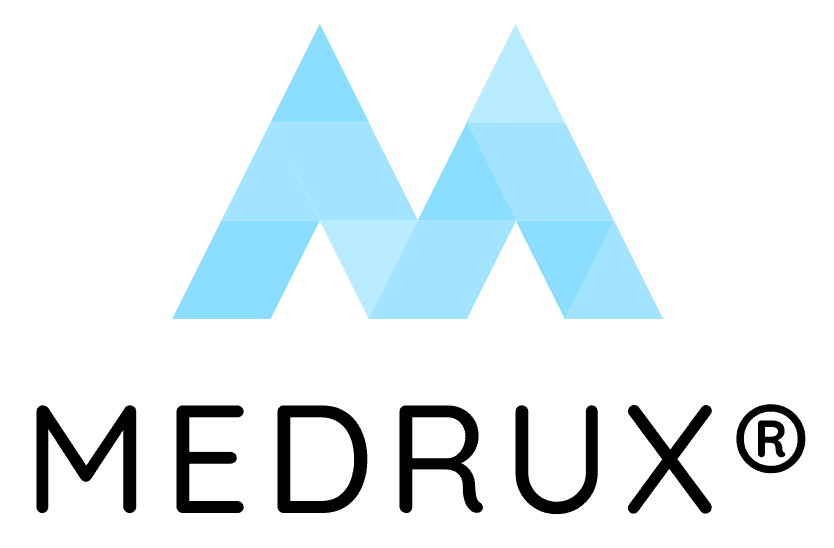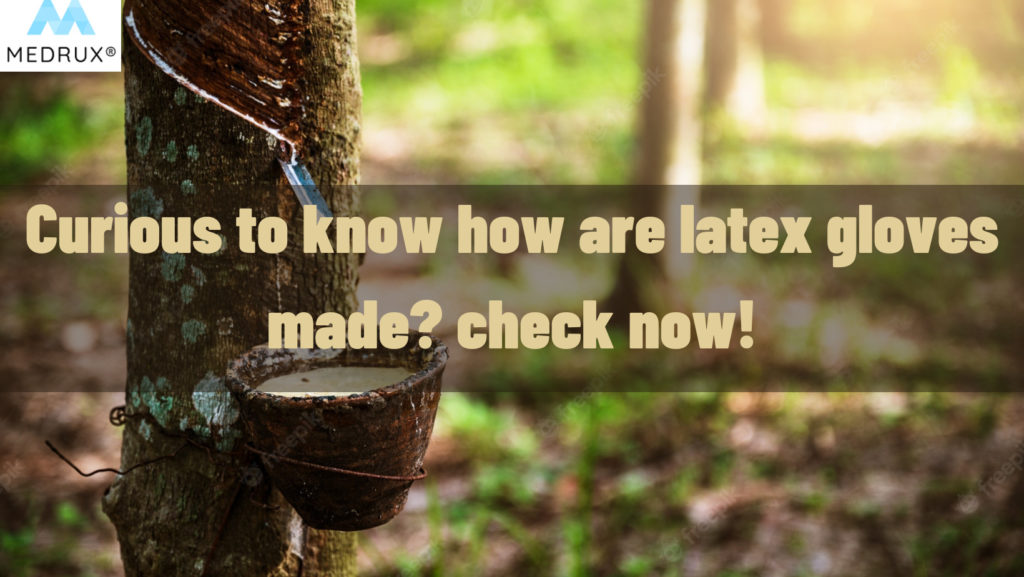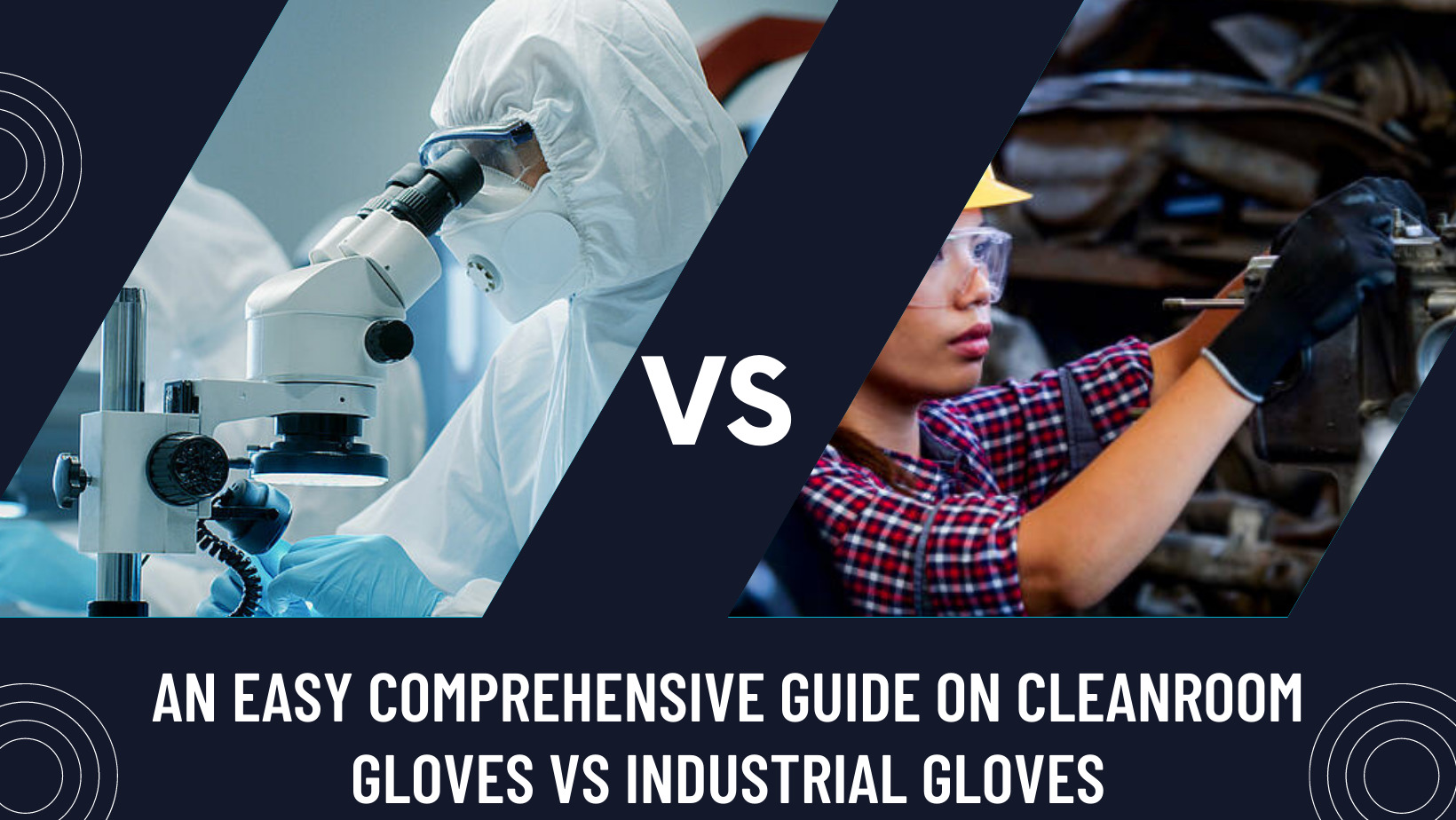Have you looked at a pair of latex gloves and wondered how they are made?
How can such a thin glove fit your hand like a second skin and make you feel everything you touch to be this strong against many things like cuts and tears?
How can something look so delicate and waterproof and doesn’t let anything in?
Whether working in your garden, garage, or kitchen using industrial grade latex gloves or a professional surgeon or healthcare worker using surgical and medical grade latex gloves.
You must have worn latex gloves or seen people around you wearing them at some point in your life.
And definitely, you bought a box or two in the last two years to protect yourself against COVID-19.
Latex is of high importance as it’s an essential raw material for creating more than 40,000 products in our daily lives throughout history, such as medical devices, gloves, car tires, clothes, pacifiers, etc.
In our article, we will take you on the journey of how latex gloves are made;
- What is latex?
- What are the latex gloves’ best and worst characteristics? And why should you have them?
- A brief history of latex
- The extraction process of latex
- The production processes of latex gloves
- Slurry dipping…. How are Powdered latex gloves made?
- Chlorination… How are powder-free latex gloves made?
- How are sterile latex gloves made?
- The Quality control phase
What is latex?
Latex is the oldest and most commonly known material for producing disposable gloves.
For many decades, latex has been the gold standard for gloves.
However, this is no longer the case, as many alternatives, such as nitrile, neoprene, and vinyl, have taken over the disposable glove market.
Yet, latex remains one of the most used materials in the world of disposable gloves and many other industries.
Natural rubber latex (NRL) is a polymer derived from natural rubber trees, also known as (Hevea brasiliensis).
It’s also referred to as the Pará rubber tree—after the Brazilian state of Pará—because it was originally cultivated in Brazil.
However, nowadays, rubber latex comes from trees cultivated in Malaysia, India, Indonesia, Thailand, and Vietnam.
Latex is a milky liquid that is found in the latex ducts.
It can also be found in the cells of many rubber-producing plants.
Latex function in the tree is to help the trees heal after being cut or damaged like platelets coagulate in our blood to cover a wound.
The latex rubber coagulates and stops the tree from bleeding. It also blocks harmful bacteria and insects.
Let’s see what latex gloves are and how important they are in different industries.
What are the latex gloves’ best and worst characteristics?
Latex gloves are infamous for their superior elasticity. They fit the hand like a second skin.
Similarly, they have the exquisite ability to stretch without tearing or breaking, making them the most comfortable type of glove with high tactile sensitivity.
This is a highly appreciated feature for people who need high touch sensitivity, dexterity, and precision in their jobs.
Latex gloves are highly valued in the medical field by doctors, surgeons, nurses, dentists, and homecare givers.
Why?
Because of their high protection against microorganisms such as bacteria, viruses, and fungi.
Additionally, they are cut and tear-resistant, making it easy to handle different sharp instruments.
Furthermore, they provide the excellent dexterity and precision needed for different levels of skills.
Latex gloves are biodegradable; they come from natural sources hence, they are a great option for eco-friendly people.
Moreover, latex gloves are durable and offer good resistance to many acids and alkalis.
And they come in different colors and sizes and for multiple purposes.
That’s why you can find latex gloves in many fields such as food production, industrial fields, mechanics and automotive work, cleaning, car washing, gardening…etc.
However, they are the preamble to many solvents. The only thing that made the world seek alternatives was latex allergies.
Latex allergies raised many concerns, especially among healthcare professionals.
They ranged from minor rashes and irritations to causing anaphylactic shocks in some individuals.
In short, despite the invention of other disposable gloves, latex gloves are widely popular and highly essential.
Latex comes from the natural rubber trees in many Asian and southeast countries, including Malaysia.
Latex gloves are crucial in many fields, including surgical operations, hospitals, industries, household cleaning, and chores.
Because they offer good protection against a wide range of hazards you encounter in your work environment or daily life.
So unless you’re allergic to latex, you will find a great companion in a pair of latex gloves to do the things you love most while keeping your hand safe.
So, now you probably want to know when the first pair of latex gloves were invented.
A brief history of latex gloves
The first modern disposable latex medical gloves were manufactured in 1964 by the Ansell Rubber Company.
Regardless, it wasn’t well-known and accepted in surgical procedures until 1893.
Why?
Back then in 1890, the understanding of the world about microorganisms and how they cause infection was limited and far away from the things we know today.
With more and more advancements in microbiology and different fields, the vitality of gloves became more and more vivid to everyone as protection for patients and doctors alike.
William Stewart Halsted, the first chief of surgery at Johns Hopkins Hospital, was the first to introduce rubber gloves into the surgical rooms.
He was not fully aware that he was giving humanity a method that saved many lives from death.
He asked a rubber company to make an experimental pair of thin gloves as a gift to his wife and scrub nurse because her hands developed contact dermatitis from the frequent chemicals used to sterilize the surgical instruments.
So, it was a love story after all that gave us medical latex gloves in surgeries.
Invented with love and developed over the years with new improvements every day, let’s begin the journey to see how latex gloves are made by taking them from the top and how manufacturers take the latex out from its sources.
How are latex gloves made; latex extraction process
Because it has a particular connected system of ducts, the Hevea tree bleeds latex when a special incision is made in its trunk.
Other trees don’t always have the same system, so obtaining latex from them is challenging.
-
Getting the latex from the trees
To harvest latex from the rubber tree, they use a process called tapping.
In simple words, tapping is how they create a unique cut using a steel knife in the tree trunk.
When the tree turns 5–6 years old, they start the tapping process, and it can live and be used for up to 25–30 years.
The cut is made in a spiral downward curve from left to right at an angle of 30°.
Directing the milky-white latex into a spigot that eventually pours into a cup attached to the tree.
Rubber trees are such early birds; it’s better to collect the sap in the early morning because it coagulates faster when the temperature is higher later in the day and could reduce the flow of the sap. Hence the amount collected.
The fluid stopped after 6 hours.
They tap the tree once every two to three days, giving it time to rest and produce more latex.
The next cut is made below the first one, and so on.
This process requires accuracy, so the cut is made right, not so shallow that it doesn’t give rubber, nor too deep that it kills the trees.
But for our eco-friendly people, don’t worry; this process doesn’t kill nor damage the tree.
Now that we’ve had our latex ready, it’s time to treat it with some chemicals so we can move it and then use it in the production process of latex gloves.
-
Moving the latex from the trees
Tapped latex is usually in a liquid (emulsion) state.
The emulsion is a complex mixture of proteins, alkaloids, starches, sugars, oils, tannins, resins, and gums that coagulate when air exposure.
Using ammonia keeps the latex in a colloidal state for extended periods.
They use formic acid to turn the latex emulsion into solid sheets
Why?
So, it can be carried easily without spilling or wasting it; to be moved to production.
Formic acid coagulated the liquid latex, turning it into crumbs.
Then the crumbs are washed, dried, and compacted into blocks or smoked sheets.
They dry them in a smoky wood fire that contains natural fungicides to help prevent the growth of molds and fungi.
The blocks are then wrapped in polyethylene sheets and then shipped.
-
Can latex be made synthetically?
Yes, by polymerizing several chemical materials found in petroleum products and suspending them in an emulsion.
Polychloroprene latex is one of the most common synthetic latexes used in glove production.
It’s usually more robust and stable than NLR for products such as tires.
Some believe synthetic latex is less likely to cause severe allergic reactions. However, people with specific chemical sensitivities may find synthetic latex to cause more problems.
To start with, natural and synthetic rubber need to undergo a series of processes to turn them into usable products.
Plasticizers such as aliphatic esters and phthalates are added to soften the rubber.
First, they shear the latex and break it down into a liquid.
This process is called Mastication.
Next, they mix it with additives such as reactive materials, fillers, oils, and protective chemicals.
Now it’s time to start making the gloves.
How are latex gloves made; production phase
The production line phase is critical. It’s where the gloves, as we know, are made.
The process manufacturing cycle takes between 40 and 60 minutes, depending on production speed.
Let’s see those phases:
-
Cleaning
First things first, cleaning!
Latex gloves are produced using ceramic or aluminum hand-shaped molds.
They are called formers or conveyors.
The formers should be cleaned first before producing a patch of new gloves.
They’re washed in soapy hot water in a rinse tank multiple times, then bleached using chlorine.
Why?
To make sure there’s no residue from the previous batches.
Next, they are suspended on a continuous moving chain and twirl through wheels to drip dry.
Finally, they go through a heavy brushing process to ensure they are particle free.
-
Chemical compounding
The latex won’t just stick to the hand-shaped mold on its own.
That’s why they first need to apply a film of coagulant material that will help the latex do that.
They dip the molds into a chemical bath, a mixture of calcium nitrate solution and calcium carbonate or stearate.
Why?
The nitrate works as a coagulant to help the latex solution uniformly stick and distribute on the mold.
Meanwhile, carbonate is a lubricant that removes gloves easily in the final steps.
Again, they are dried, twirling to shake any drops away.
Additionally, they pass through a gelling oven to partially solidify the film onto the formers.
-
Latex dipping
In a dipping tank, the molds are immersed in the latex compound.
For how long?
Well, this depends on the mil thickness of the gloves.
The longer the duration of the dipping, the thicker the gloves are.
They spin and dry again to remove any extra latex drops.
-
Leaching process
Also known as “wet-gel leaching,” freshly molded gloves are leached into a mixture of hot water and chlorine.
The effectiveness of the leaching process depends on many factors, such as water temperature, duration, and the water exchange rate.
The water must be hot and fresh enough to help make the protein dissolve better.
Why?
Remove any residual latex protein or chemicals to minimize the allergic reaction to latex as much as possible.
The more efficient the leaching process is, the higher the quality of the gloves.
-
Making the cuffs (Beading)
After drying, the gloves are rinsed again to remove more latex proteins.
Then they go through a series of brushes that roll the ends of the gloves to create the cuffs (beads).to make them easier to don and doff.
-
Vulcanization
NRL usually melts in the summer and cracks in the winter.
To overcome this, it has to go through a process called vulcanization.
It’s a process invented in 1839 and finalized in 1844 by Charles Goodyear and revolutionized the modern rubber industry.
Why?
Because it makes it easy and possible to work with rubber to create many different products, including latex disposable gloves.
The rubber is treated with chemicals such as sulfur, lead, peroxide, bisphenol, and carbon black and then through heat treatment.
Why?
To make the rubber more stable, melt-resistant, and durable while maintaining its elasticity.
-
Post Leaching
Also known as “dry film leaching.” because it’s done to the dried-out/vulcanized latex film.
Why?
To reduce water extractive.
The gloves can be leached for up to 24 hours to ensure efficiency.
After these phases, the gloves move on to either being powder-free or upgraded to sterile.
Slurry dipping…. How are Powdered latex gloves made?
Since the late 19th century, various powders have lubricated gloves for easier donning.
The first powders used were from an evergreen plant called lycopodium or club moss. But they caused inflammation and adverse events. So, they replaced them with Talcum powder, which also causes the same problem.
In 1947, cornstarch powder was introduced as a glove powder.
However, by the 1990s, they started using cornstarch solution because it was safe.
Dipping the gloves in cornstarch solution is called “slurry dipping” or “wet even powdering”.
The process is done to make it easier to put the latex gloves on, in addition to preserving the gloves and keeping the sides of the gloves from sticking together.
Again, the gloves go through more ovens to be dried to ensure that the powder is more evenly distributed and to remove any unnecessary powder.
Chlorination … How are powder-free latex gloves made?
Given the increased awareness of latex protein allergy.
In addition to the potential for powdered gloves to act as an aeroallergen, the production of powder-free gloves is rising while that of powdered gloves is declining.
In 2017, The federal Food and Drug Administration (FDA) banned the use of powdered gloves in surgical procedures or patient examinations due to their association with multiple health issues (1)
Today, various methods are available to create powder-free gloves, such as chlorination, polymer coatings, and powder-free coagulants and coatings.
In addition, they can enhance the surface grip characteristics.
Chlorination is the most commonly used method for NRL gloves.
The chlorine is detrimental to the physical properties of the glove. For this reason, the chlorination process must be carefully controlled.
Why?
Because over-chlorination can cause discoloration and lousy odor resulting in a shorter half-life and poor physical properties for the gloves.
After the vulcanization step, the gloves are cooled in cooling tanks, then passed through online chlorination.
The chlorine reacts with the glove’s surface, changing its molecular structure and turning it from incredibly tacky to silky smooth.
This offers quick and easy donning (as this will be the inside of the glove)! The glove is turned inside out, and the process is repeated.
The higher the concentration of chlorine, the smoother the glove becomes.
How are sterile latex gloves made?
In 1894 Joseph Lister. became the first person to sterilize the rubber gloves used in surgeries.
Nowadays, after all the previous steps, whether powdered or powder-free, the gloves go further into special washing machines.
They are washed in di-ionized, UV-treated water, filtered to 0.2 microns, and then moved to cleanrooms.
In cleanrooms, they are dried using very high-quality HEPA-filtered air and then packed.
Finally, after finishing all the processes while the gloves are still on the mold, air jets strip the finished gloves from the formers.
To summarize,
After cleaning the molds, the gloves are dipped in a solution of chemical coagulants and lubricants to enable latex adhesion when later dipped in latex solution.
The latex gloves are leached to reduce latex protein residuals before being vulcanized to increase durability while maintaining elasticity. Then comes the post-leaching process, which further reduces water content and latex proteins.
Powdered gloves are made by being dipped cornstarch solution. While powder-free latex is chlorinated, both are done to make donning latex gloves easier.
Testing can begin as soon as the gloves are taken out of the molds!
How are latex gloves made; the Quality control phase
Gloves must be tested to ensure their high quality and working properly.
Gloves are tested using methods and standards from the American Society for Testing and Materials (ATSM) regulated by FDA.
Latex gloves go through a critical test called the Pinhole leak test.
In this test, they fill the gloves with one liter of water, close them, and hang them for a few minutes before squeezing them.
Why?
Even though gloves have pinholes, this ensures that they’re not big enough for water to reach the skin.
Latex gloves must also pass additional tests for aqueous extractable and antigenic protein content.
Medical grade latex gloves, of course, need more testing than industrial grade latex gloves and sterile methods of packing as well.
Such as dimension tests and specific thickness requirements, aging tests, and, more importantly, sterility tests.
The test must stick to guidelines of accepted quality limits (AQLs):
When the AQL is 2.5%, only 2.5 gloves out of every hundred will fail the quality test.
If the batch exceeds this percentage of the total batch, all the gloves in that patch fail.
AQLs for latex gloves:
- Industrial-grade is: 2.5%
- Medical-grade is: 1.5%.
After all the processing and testing on the gloves, it’s time for them to get some rest and start dressing up to do the part they are made for.
Hence, they’re packed and delivered to us. To keep their sterility, sterile gloves are packed into cleanrooms.
In the end,
All the processes above must be done accurately and controlled carefully to ensure we have the best quality.
We hope you enjoyed the journey of how latex gloves are made. Feel free to send us anytime for more questions and inquiries.
Hajar Nagdy is a microbiologist and a lecturer. Nagdy holds a Bachelor’s degree in the fields of microbiology and environmental sciences, and she is now a M.Sc. candidate in microbiology. In her free time, she can be found listening to classical music, reading interesting scientific articles, running a charity, or traveling across Europe.








